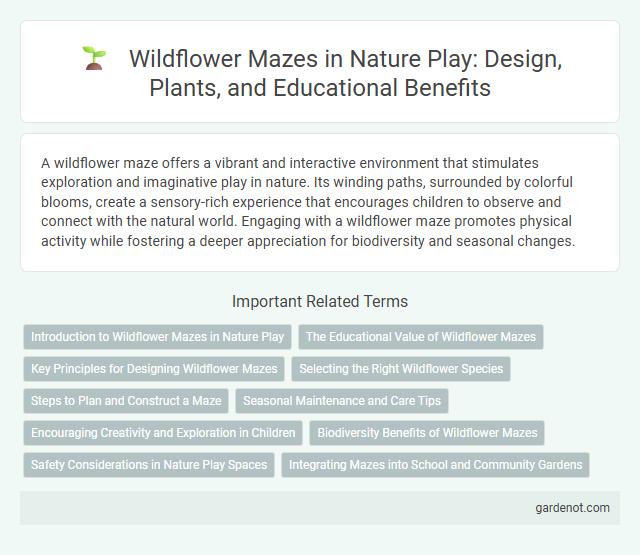A wildflower maze offers a vibrant and interactive environment that stimulates exploration and imaginative play in nature. Its winding paths, surrounded by colorful blooms, create a sensory-rich experience that encourages children to observe and connect with the natural world. Engaging with a wildflower maze promotes physical activity while fostering a deeper appreciation for biodiversity and seasonal changes.
Introduction to Wildflower Mazes in Nature Play
Wildflower mazes in nature play create immersive, sensory-rich environments that encourage exploration and learning through natural elements. These mazes enhance spatial awareness and cognitive development by integrating native wildflower species, supporting local biodiversity and seasonal changes. Engaging children in wildflower maze activities promotes environmental stewardship and strengthens connections to natural habitats.
The Educational Value of Wildflower Mazes
Wildflower mazes provide immersive learning environments that enhance sensory development and botanical knowledge through direct interaction with native plant species. These interactive spaces support ecological education by illustrating plant life cycles, pollination, and biodiversity in a hands-on, engaging manner. Integrating wildflower mazes into nature play encourages environmental stewardship and fosters curiosity about natural habitats among children and adults alike.
Key Principles for Designing Wildflower Mazes
Wildflower mazes emphasize biodiversity by incorporating native wildflower species that support local pollinators and create vibrant habitats. Design principles prioritize natural pathways that encourage exploration and sensory engagement, promoting environmental education through immersive experiences. Spatial layout integrates sustainable practices such as minimal soil disturbance and water-efficient planting to ensure ecological resilience and long-term vitality.
Selecting the Right Wildflower Species
Selecting the right wildflower species for a wildflower maze ensures vibrant blooms and ecological balance throughout the growing season. Native species like Black-eyed Susan, Lupine, and Purple Coneflower thrive in local soil and climate conditions, attracting pollinators such as bees and butterflies essential for biodiversity. Choosing drought-tolerant and low-maintenance varieties reduces water usage and upkeep, making the maze sustainable and visually captivating.
Steps to Plan and Construct a Maze
Designing a wildflower maze begins with selecting a suitable location that receives ample sunlight and has well-drained soil to support diverse native wildflowers. Next, map out the maze layout using pathways wide enough for safe navigation, ensuring the design balances complexity with accessibility. Planting involves choosing a variety of wildflower species with staggered blooming periods to maintain vibrant colors throughout the seasons, followed by consistent watering and minimal maintenance to encourage natural growth.
Seasonal Maintenance and Care Tips
Wildflower mazes require seasonal maintenance to thrive, including regular weeding, watering, and deadheading to promote healthy growth and vibrant blooms. Adjust irrigation schedules based on seasonal rainfall and soil moisture levels to prevent stress on plants and encourage deep rooting. Implement periodic soil testing and amend with organic compost in early spring and late fall to maintain optimal nutrient balance for wildflower varieties.
Encouraging Creativity and Exploration in Children
A wildflower maze stimulates children's creativity by offering a dynamic environment rich with diverse colors, textures, and scents that inspire imaginative play and storytelling. Navigating the maze enhances problem-solving skills and spatial awareness as children explore different paths and discover hidden corners. This interactive natural setting fosters curiosity and encourages outdoor learning, promoting emotional well-being and cognitive development.
Biodiversity Benefits of Wildflower Mazes
Wildflower mazes enhance biodiversity by providing essential habitats for pollinators such as bees, butterflies, and native insects. These vibrant ecosystems support a diverse range of plant species, promoting genetic variation and resilient local flora. Increased biodiversity in wildflower mazes also contributes to improved soil health and natural pest control, fostering a balanced environment.
Safety Considerations in Nature Play Spaces
Designing wildflower mazes in nature play spaces requires careful attention to safety measures such as non-toxic plant selection and clear sightlines for supervision. Pathways should be wide enough to prevent crowding and constructed with non-slip, natural materials to reduce fall risks. Incorporating gentle gradients and ensuring regular maintenance helps create an accessible and secure environment for children and caregivers.
Integrating Mazes into School and Community Gardens
Wildflower mazes offer an enriching way to integrate nature play within school and community gardens, boosting ecological awareness and sensory engagement among children. These vibrant, plant-filled pathways enhance biodiversity by supporting pollinators like bees and butterflies while serving as dynamic outdoor classrooms. Incorporating wildflower mazes into educational gardens encourages physical activity, creativity, and environmental stewardship in young learners and local residents.
Wildflower maze Infographic

 gardenot.com
gardenot.com